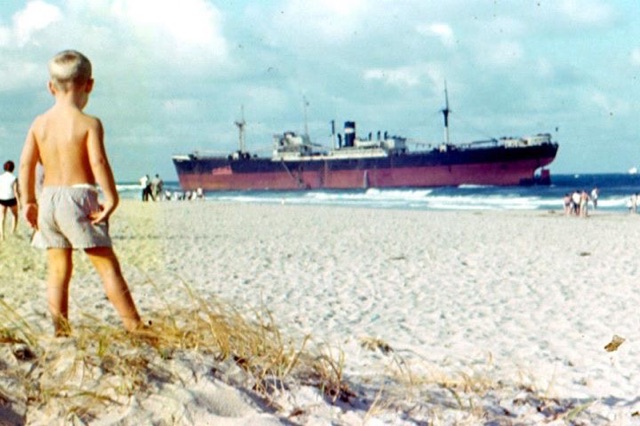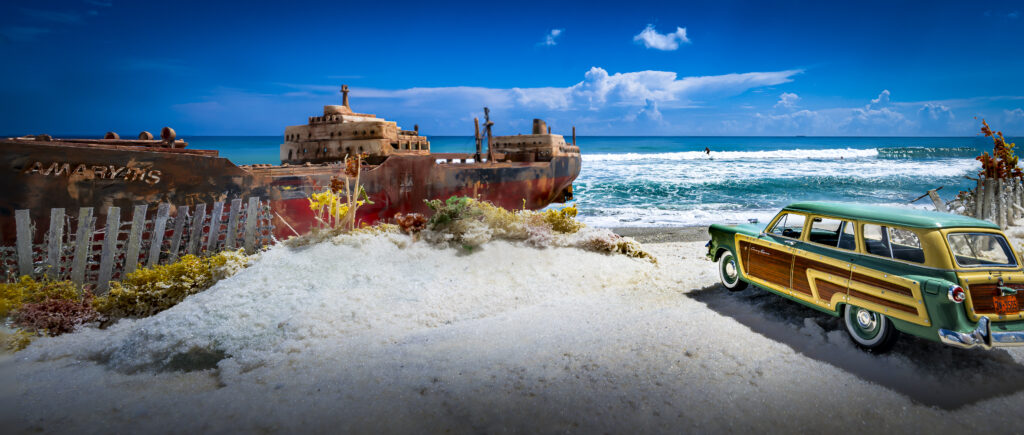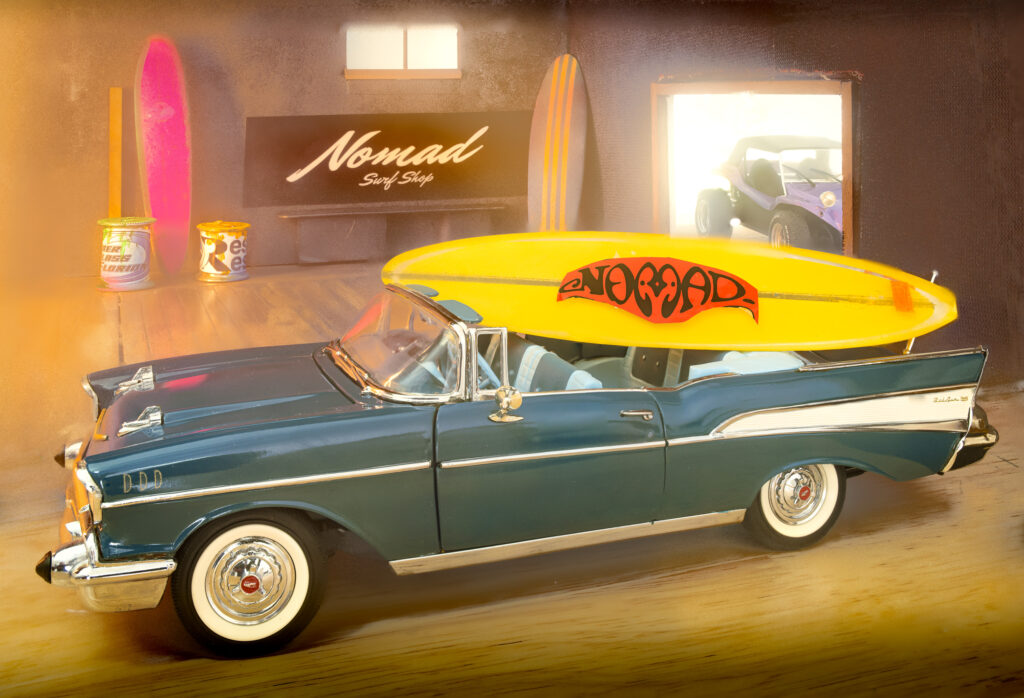
Think of landscape photography with a twist. “Dreamscape” photography is my latest project.

I start by remembering a moment. This one is September 1965. I was nine years old and although now its sixty years later, I can visualize the day like it was yesterday. The sands were packed with surfers and their longboards. It looked like a giant party. It was the day, I said to myself, “When I’m a teenager, I have got to get a surfboard!”

To re-create the memory, I bought a used toy Texaco Oil Tanker purchased on E-Bay for $20. For the ship’s name, I pressed on some letters from the art store..”.Amaryllis”. I added “rust” and graffiti to the ship with acryllic paints. The base is a piece of wood with beach sand poured over some epoxy dunes. The most important step was waiting for a day when the water was clear blue and a ground swell was pouring in from the north. I waited a month for the surf to show up–and then my memory was complete!
Here is the story of the Hurricane of 1965 and the Amaryllis Shipwreck on Singer Island.
The Wreck of the Amaryllis
For South Floridians, September is Hurricane Nail Biting month–the peak of the annual season with a 30% chance of being targeted by a storm. Hurricane forecasting in the year nineteen sixty five, primitive by today’s standards, was propelled entirely by “word of mouth”. Satellite photos of the Caribbean did not exist. Hurricane Betsy hit with a day’s notice- a radio report from the Bahamas. By the time local TV news began reporting, a miraculously moisture free blue sky shone with gale force winds but no clouds. Something big was about to happen. Everyone could see it and feel it, however until the storm bands appeared on Miami radar, the hurricane’s size and intensity were anyones guess.
At sea, this lack of information would be tragic for the Greek registered freighter, Amaryllis. Traveling from Manchester England to Baton Rouge Louisiana, the captain chose a route above the Bahamas that required the ship turn south at the Grand Bahama Banks. This shortcut had a major flaw. For fifty miles the ship would be motoring against the nine knot current of the powerful Gulf Stream. To minimize the effect, the captain chose to tuck-in close to the Florida coast, a choice that would prove to be disastrous.
For the souls at sea, a red sunset struggled through a blanket of seaspray. Soon after, when the gales increased to hurricane force, the ship found itself sliding down the slopes of thirty foot ocean swells, its prop and rudder leaving the water as its bow plunged into deep ravines between waves. Midnight brought a hundred and fifty miles per hour sideways rain. The fury hurtling the ship forward while the captain fought the steering wheel for control. Nature gave the Amaryllis it final act of savagery. The oncoming current bunched the now gigantic swells into one horrific behememoth as high as the ship was long. The ship rose and rose into the sky. The rudder snapped and the crew experienced the full terror of the ocean. The breaking wave launch the ship forward. Were it not to land on sand and reef, the frieghter would have been driven to the bottom of the sea. All hands were thrown violently backward as the ship surfed the rogue wave safely up the beach of Singer Island. The sailors said a prayer of thanks and waited out the storm to be rescued.

For those on land, one mile from the wreck, the night was terrible in a different way. My mother, younger brother and I spend the hours of blackness huddled in a clothes closet listening to a pocket sized transistor radio. My father, in California on business, phoned earlier and suggested we crisscross our home’s sliding glass windows with masking tap–it was a fool’s errand made to give us a sense of security, until he could get a flight home. The winds howled and screeched. The voice on WJNO radio kept us company. The wall sized windows rattled loudly for hours, and then, we must have fallen asleep. All was calm when we awoke and the radio batteries long dead. Mom opened the door and sunshine filled our hideout. Our home remained sealed and dry.
My Dad arrived in the afternoon, parked a half mile away and waded home with suitcase in hand. We began a few long days of shoveling wet sand off the just planted St. Augustine grass. Our home was built on a hill with a golfing fairway in back, now underwater, and street in front, also now a giant lake. By the weekend, all was back to normal, and my swim team best friend and his Dad drove me to the beach to see “The Ship”. I can picture the scene like it was yesterday. The sands were packed with gawkers and kids running with surfboards. The ship had created a Malibu-like surf paradise. The entire beach was giant teenage party. One look and my nine year old mind snapped into focus. “Somehow, I’m going to get a surfboard!”




“Ron the Nomad”
In 1969, surfboards shrank from nine feet to seven feet and shed thirty pounds of weight. They also transformed from bland colored logs into candy colored masterpieces of psychedelic artwork. The artist’s soul in my thirteen year old heart raced at the idea of custom making a surfboard.
Two local surfboard makers–Fox and Nomad competed. I was not inspired by the Fox boards. The Fox boards and their hotshot team riders surfed great. But, but in my opinion, the Nomad surfboards starting to show up around the beach, exhibited superior craftsmanship. Easily spotted from afar,
a Nomad surfboard boasted a bright glass-job with colors like grape, yellow, tangerine and cherry red.
Up close, the coloring’s transparent tint showed the sparkle of the shaped white foam blank beneath and the blonde wood balsa stringer. Best of all was the hippie influenced decal drawn by California artist Jim Ogden. Nomads looked like big pieces of candy! The man responsible for creating them was named Ron Heavyside.
With fifty dollars of saved lawn money, I asked my Mom to drive me to the Nomad factory in a Hypoluxo Industrial Park. At first we drove around and couldn’t find a sign. A parked dune buggy and some drums of Polyurethane resin were the only clue to the workshop. My Mom waited in the car and I opened a the which turned out to be a glassing room. It revealed a treasure trove of acid wash multi-colored colored boards drying on wall racks. The room was empty, so I follow the high pitched scream of a power planner coming from the adjacent bay. It took a bit all the courage I could muster, to open the door–I knew I was interrupting a job in progress.

In front of me stood a 6’3 giant with a blonde ball of hair extending an additional four inches. He wore a breathing mask like a WWI trench warfare soldier and when he pulled it down, he gave me the ten thousand yard stare, “What?” he asked impatiently.
In a long nervous run-on introduction, I begged him to sell me a blank and some fiberglass cloth.
“I love your boards, and I have cash”
“Then go to my shop on the beach and buy one”
“I have sixty dollars of lawn mowing money. I came from all the way from North Palm Beach.
North Palm Beach, holy shit, how did you find this place, he said sarcastically.
“My mom drove”
He stared at me for a moment and then softened.
“Alright, alright, just this once”
Ron Heavyside took the end of a compressed air hose and sprayed the layer of snow-like foam dust from his head, shoulders and arms. ..I’ve got boards to shape all day. I don’t have time for this shit”
I quickly scanned the room. On the wall was hung templates and calipers.
Well?
I pointed to a Surfer double page color spread masking taped to the wall.
” That’s Lesley Potts at Honolua Bay.”
“Look kid, You are gonna need a blank, four yards of six ounce and two gallons of resin and an inbox.
I don’t have an extra fin to sell you. Get one somewhere else.”
We stepped outside and he filled my empty milk jugs with resin.
My Mom leaned out the car window, waved to him and said brightly, “Thank you, sir!”
“I also need some orange transparent pigment.”
He shook his head. “Then you promise to never come back?”
My first business success began that day thanks to Ron Heavyside.
Over the next five years, I returned every two months and each time, Ron shook his head, sighed and said,
“Ok show me your latest boards.”
He would then look them over and offer a tip on shaping, glassing, sanding or hot coating.
My Mom would wave from the car and yell, “Thank you again”.
He has passed now, but his success lives on in his children that operate his retail store
in Briney Breezes. If Ron were here today, I would thank him for the patience and consideration he gave me. What a person of great talent and character!
###


“Big Daddy” Don Garlits–Florida’s Swamp Rat
One Friday evening in 1965 my father took me to Palm Beach International
Speedway for some father son bonding. I was eight years old and was
excited to just be up a 8pm let alone in the front seat of the car headed to
where grown ups watched hot rods and dragsters set speed records and
sometimes crash and explode.
At home, we had a stack of HOT ROD magazines. I had read about
“Florida’s Swamp Rat” the racer who poured Nitro
(glycerine?) into his homemade dragster and beat all of the hot shot
California based hot rodders who thought they owned the sport. Mostly I
read the small ads in the back for “Rat Fink T-Shirts” and of course any ad
that had a photo of a partially clad woman which as luck would have it, seemed to be the
marketing strategy of all car racing companies.
On the drive west of Jupiter Florida, my Dad explained his job.
“I sell Permatex adhesives used by hot rod racers. These are tough, hard
working guys who came back from the war with mechanical experience.
These guys re-build their own cars adding high-performance headers,
cams, rocker arms, fuel injections systems then race every weekend. They
do this all over the country at old airport landing strips. The race is a
quarter mile long, and you know the fastest—“Big Daddy Don Garlits” we
repeated together.
We parked in a field of grass, sticker burrs and beer bottles— then walked
through the fence and gate. My Dad seemed to know everyone. He
grabbed a head set and put it over my ears. I still felt the ground vibrate
with each distant race. We walked past cheering crowds in bleachers.
Bright Floodlights illuminated flags, painted walls, banners, posters,
and stickers. Every free space on each vehicle was covered with sponsor names and logos:
Wynns, Bardahl, Hurst, Crane Cams, Cragar, Valvoline.
As we approached the starting line, the ground vibrations were replaced by thunderous blasts of energy, oil
fumes and showers of asphalt gravel. We walked behind the line of dragsters shooting
flames from their engines and smoke from their tires and
and ducked for cover behind the concrete starting tower. I was already
petrified, when Dad yelled, “Stay right here, Don’t move. I’ll be right back!”
While scrambling up a metal staircase to the top.Even through the thick pads of the headset, I heard a piercing scream and
peeked around the building to witness crews pouring bottles of bleach
onto a dragster’s massive back tires. The driver then hit the gas pedal hard
and did a “Nitro Burnout” sending a hot flame my way. The crowd stood
on their benches and waved their arms. The dragster shook violently. The
engine cracked, popped a thousand backfires blowing smoke and flame.
I swear the hair on my arms singed. The wheels spun and the driver
appeared as a dot a quart mile away obscured by a white and red
parachute. I was covered in hot oily mist and pieces of tarmac.
Dad grabbed my arm and led me to a place called “The Pits”.
We watched from afar while Don Garlits and his team fine-tuned his engine.
You could feel the intensity and focus of everyone around him.
Sixty years later, I turned off the Florida Interstate exit just south of Ocala and
pulled into the lot of the Don Garlits Museum of Drag Racing. The entrance
road led past an Ocala ranch style home and ended at two
airport sized hangers. I entered, bought a ticket and walked into an enclosed arena, filled with polished dragsters. Each vehicle was carefully arranged with
detailed storyboards, trophies and memorabiilia. Don Garlits, the man who
began a career from scratch as Floridian “Swamp Rat” had built an exhibit with the quality level
of the Smithsonian Institute. What else should I have
expected from the intensely focused perfectionist who spent a lifetime being the very best.
The museum included with several hundreds of racers, most his original dragsters and hot rods,
and many of those once owned by this competitors. Each vehicle was arranged in
chronological order and restored to showroom finish– so perfectly , that
I imagined one could turn an ignition and fire one up!
I recognized the Swamp Rat dragster I saw at the mid 60’s drag race in West Palm.
The next one in line had with it a video short that I stopped to watch. In the first scene,
the dragster launches from the starting line in
the usual flume of fire and smoke, but then explodes sending the pieces
backward into the body of its driver. The documentary goes on to explain that
pieces of the transmission nearly
took off Don Garlit’s foot. The hot oil and fuel burnt him badly. After a
hospital stay and vow to retire from the dangerous sport, he had an
inspiration. “Build the next one with the engine in back of the driver!”
So, instead of retiring, he went on racing and winning. Adding merit to his
race wins, he also innovated safety
features for the industry such as the head-to-toe flameproof Nomex suits and bacclavas worn
today in all forms of motorsports. The man that California hot rodders
once ridiculed as a rat from Florida , is today recognized world-wide as the father of drag racing.
A Don Garlits dragster is enshrined in the Smithsonian Institute’s
Museum of American History in the same room as Henry Ford’s Model T.


The Miami Serpentarium–Many Years of Nightmares
